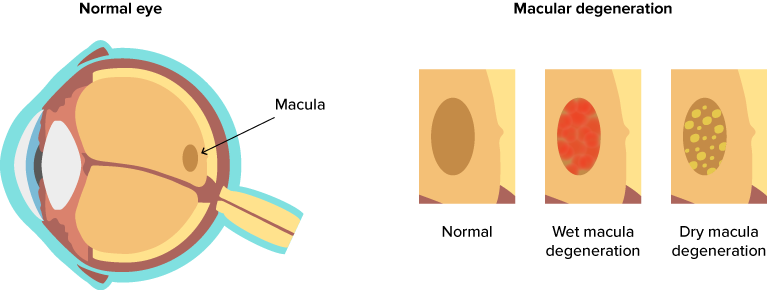Age-related macular degeneration (AMD) affects the macula. The macula is on the central part of the retina, which is located on the inner layer at the back of the eye. It is responsible for detailed central vision, like reading, driving, watching television and recognising faces.
Macular degeneration causes the centre of your vision to blur or distort, while the side or peripheral vision remains unaffected. It is generally related to the aging process of the eye, although it can occur earlier in some patients. However, while there is no cure, early diagnosis and preventative measures can delay or reduce any central vision loss.

There are two types of AMD:
- Dry AMD – The dry type is the most common. This is the milder form, where there are gradual wear and tear of the central retinal cells/tissues from the macula area, and the symptoms generally develop slowly over time
- Wet AMD – In the wet form there is sudden leakage or bleeding from weak blood vessels under the macula, and the symptoms are more severe and progress more rapidly
If the dry form is diagnosed it must be monitored closely, as it can occasionally develop into the wet form over time.
What are the SYMPTOMS of AMD?
In the very early stages, macular degeneration is symptom-free, however, it can be detected during a routine eye examination. Patients don’t experience any pain with AMD.
The most common early symptoms are the wavy or distorted central vision. This can be noticed whilst performing any tasks that require seeing in detail, for example reading. Patients may experience a blurred spot, or the feeling there is dirt in the way of clear vision, which cannot be corrected with glasses. Over time, the damaged area may increase in size and interfere with reading and recognising faces.
What is the TREATMENT of AMD?
Early diagnosis is crucial, as there is currently no cure for AMD.
With dry AMD the following lifestyle modifications can help slow down the degeneration:
- Exercise
- Wearing UV blocking lenses
- A healthy diet with plenty of green vegetables and anti-oxidants.
- Ocular vitamin supplements including lutein, zeaxanthin and vitamins C, E and Zinc, can also assist in slowing the progress of AMD
- Stop smoking
Wet AMD can be treated with injections of anti-VEGF therapy into the eye to stop leaking blood vessels.
How can I PREVENT getting AMD?
- Lifelong UV protection and good nutrition are known to play key roles in preventing AMD
- Living a healthy lifestyle by keeping your blood pressure down, reducing intake of fatty foods and not smoking are all recommended
- A healthy diet consisting of high antioxidants, such as leafy green vegetables and fruits, also helps prevent AMD
- Regular thorough eye examination and retinal scans are vital for early detection of AMD
If you present with symptoms indicative of AMD, your optometrist will dilate your pupils, which will give them a clearer, and more detailed view of the back of your eyes.

